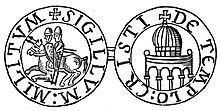From Wikipedia, the free encyclopedia
 Knights Templar Seal
Knights Templar Seal of the Crusader period, showing the Dome of the Rock on the reverse.
[1]
The
Temple of Solomon was anachronistically depicted as the Dome of the Rock in Western iconography well into the early modern period (here in a print by Salvatore & Giandomenico Marescandoli of
Lucca, 1600)
The Templum Domini[2][3] (Vulgate translation of Hebrew: הֵיכָל יְהֹוָה "Temple of the Lord") was the name attributed by the Crusaders to the Dome of the Rock in Jerusalem.[4] It became an important symbol of Jerusalem, depicted on coins minted under the Catholic Christian Kingdom of Jerusalem.
The Dome of the Rock was erected in the late 7th century under the 5th Umayyad Caliph Abd al-Malik ibn Marwan at the site of the former Jewish Second Temple (or possibly added to an existing Byzantine building dating to the reign of Heraclius, 610–641).[5] After the capture of Jerusalem in the First Crusade (1099), the Dome of the Rock was given into the care of Augustinian Canons Regular. At first, the rock around which the shrine had been built was left uncovered and the canons placed an altar on it. Later the rock was covered with white marble and an altar choir constructed upon it, a work that likely was completed only in 1140. In 1138 the Templum Domini was raised to the status of an abbey and on 1 April 1141, the church was dedicated solemnly by papal legate Alberic of Ostia, possibly to St. Mary.
The adjacent Al-Aqsa Mosque was called Templum Solomonis ("Temple of Solomon") by the Crusaders. It first became a royal palace. The image of the Dome, as representing the "Temple of Solomon", became an important iconographic element in the Kingdom of Jerusalem. The royal seals of the Kings of Jerusalem depicted the city symbolically by combining the Tower of David, the Church of the Holy Sepulchre, the Dome of the Rock and the city walls.[citation needed]
After the completion of the purpose-built royal palace near the Jaffa Gate and to the south of the Tower of David,[9] the King of Jerusalem gave the building to the Catholic monastic-military order, the Knights Templar, who maintained it as their headquarters. The Dome was indicated on the reverse of the seals of the Grand Masters of the Knights Templar (such as Everard des Barres and Renaud de Vichiers), and it is possibly the architectural model for round Templar churches across Europe.[10]
Although the adjacent Dome of the Ascension was constructed as a baptistry during the Crusader period, it has since remained in the hands of Islamic authorities as part of the larger complex of the Dome of the Rock. It turned back into a mosque after the crusaders. [11][12]

